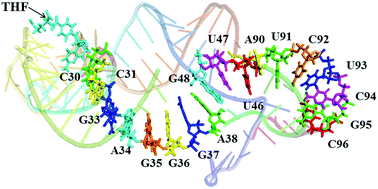Allosteric pathways in tetrahydrofolate sensing riboswitch with dynamics correlation network†
Abstract
Riboswitches are cis-acting genetic control elements. Due to their fundamental importance in bacteria gene regulation, they have been proposed as antibacterial drug targets. Tetrahydrofolate (THF) is an essential cofactor of one-carbon transfer reactions and downregulates the expression of downstream genes. However, information on how to transfer from the binding site of THF to the expression platform is still unavailable. Herein, a nucleotide/nucleotide dynamics correlation network based on an all-atom molecular dynamic simulation was used to reveal the regulation mechanism of a THF-sensing riboswitch. Shortest pathway analysis based on the network illustrates that there is an allosteric pathway through the P2 helix to the pseudoknot, then to the P1 helix in the THF-riboswitch. Thus the hypothesis of “THF-binding induced allosteric switching” was proposed and evaluated using THF and pseudoknot weakened experiments. Furthermore, a possible allosteric pathway of C30–C31–G33–A34–G35–G36–G37–A38–G48–G47–U46–A90–U91–C92–G93–C94–G95–C96 was identified and confirmed through the perturbation of the network. The proposed allosteric mechanism and the underlying allosteric pathway provide fundamental insights for the regulation of THF sensing riboswitches.


 Please wait while we load your content...
Please wait while we load your content...